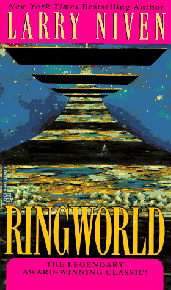

RINGWORLDby Larry NivenDel Rey0-345-33392-6288pp/$5.99/1970 |
 |
The Ringworld may be considered one of science fiction's greatest Big Dumb Objects. Designed by Larry Niven in the late sixties, the novel told of the quest of a band of four sentients to explore the most gigantic artificial world known to man, kzin or puppeteer. The Ringworld was so big, it completely dominates the novel Niven wrote about it.
Ringworld begins modestly enough with the celebration of Louis Wu's two-hundredth birthday. Bored, Wu begins traveling around the globe, always ahead of the midnight line, in order to extend the event and finds himself in the company of a puppeteer, a strange alien race unseen by humans for several centuries. This puppeteer drafts Wu, a Kzin named Speaker-to-Animals and a human woman named Teela Brown to go on the aforementioned expedition.
Although Niven attempts to weave various subplots into the story, none of them are as interesting or as well thought out as the actual Ringworld. The idea that puppeteers were breeding humans for luck, resulting in Teela Brown, never really becomes believable, even though the three males on the expedition all buy into the theory eventually. Similarly, there is little spark in the relationship between Wu and Brown, or even the tension which arises between the various humans, kzin and puppeteer as they explore a minute portion of the Ringworld's vast surface area.
Furthermore, although Niven gives much of the background necessary to enjoy the novel, full enjoyment can not be achieved unless the reader has a familiarity with several of the short stories and novels which form the Known Space Cycle of stories Niven has written, although this knowledge becomes even more important for someone who is reading Ringworld's direct sequel, The Ringworld Engineers.
Putting these shortcomings behind, the Ringworld itself still looms above everything else. This is truly a concept too big for a single novel. Niven continuously gives hints of the mysteries which abound on the gigantic ring, yet few are actually spelled out. Furthermore, although there is evidence of vast quantities of life, the only creatures the foursome seem to run into are extremely human. Niven doesn't even begin to address the issue of where these humans are from.
Ringworld is definitely worth reading, but not as a stand alone novel. I would recommend picking up some of Niven's short stories, Tales of Known Space spring to mind, before reading Ringworld. I would also plan on continuing with The Ringworld Engineers to fill in much of the information Niven left out.
 .
.
